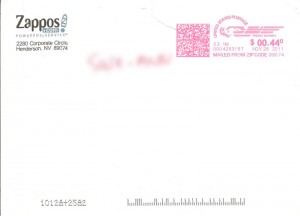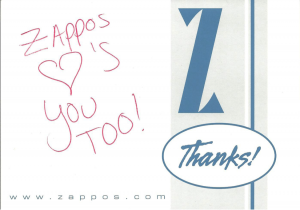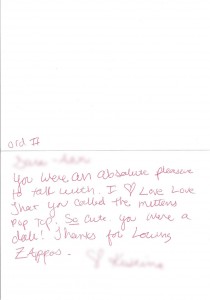Small businesses have a big advantage over their super-sized competitors – the ability to have more one-on-one interactions with customers. Many small businesses try to differentiate themselves based on this personal service and how well they know their customers. However, these businesses still need to prove that they provide a great experience to attract customers and keep them coming back.
One way to do this is by taking the time to personally thank customers – preferably right after they make a purchase or have a good experience. An example of a company that does this well is Zappos.com. Although Zappos.com is a big company, they successfully use the “small and personal” approach to turn their customers into their biggest cheerleaders.
Zappos.com Delivers the Personal Touch
My wife is fanatical about Zappos.com. She’s petite, so she often has difficulty finding things that fit her. As a result, she sometimes needs to call customer service with questions prior to placing her order online. This actually benefits both parties: my wife gets stuff that fits her the first time, and Zappos.com avoids extra return shipping costs.
My wife recently called the Zappos.com customer service line about a pair of “pop-top” mittens that she wanted. These trendy mittens allow her to “pop” the fingers off to use her iPhone, get a better grip on her morning tea and do other useful stuff. She had such a great customer experience with her rep, Kristina, that the call culminated with her saying, “I love Zappos.com!”
So, what did Kristina do afterward? While most companies would chalk this order up as a “win” and move on, Kristina – probably because she was trained to do so by Zappos.com – took the time to send a hand-written thank you card. The outer envelope was personally addressed.
The front of the card was branded, but Kristina also wrote a nice message based on a specific comment that my wife made while they were on the phone.
The inside of the card not only referenced her order number – which is helpful she needs it in the future – but also referenced my wife’s conversation with Kristina.
The entire communication was a “home run” in terms of further proving to my wife that Zappos.com is THE BEST place for her to shop for shoes and clothing. When she received this card, she was utterly floored. She put the card on the refrigerator for us to see on a daily basis and she also showed it to friends and family.
What Small Businesses Can Learn from Zappos.com
What Kristina did wasn’t a random act of kindness. Zappos.com recognized an opportunity to quickly reinforce great customer experiences. I’d bet that Kristina’s sales manager trained her on how and when to do this. Zappos.com probably gives all of their representatives a stack of cards and the discretion over when to send them.
Small businesses can easily do something similar. It just takes a little planning and some ongoing organization to improve customer service and loyalty. Here are five steps towards becoming a customer service superstar:
- Determine who in your business should be involved. Is it just the owner, or are there other employees who are critical for building customer relationships?
- Communicate the idea and consult your staff about a process that they feel works for them. It’s critical that your staff is willing to execute the program on a regular basis. To help with their willingness to execute on the program, make sure it is simple for them to get their notes out to their customers. (Did you notice the Zappos envelope had a Pitney Bowes indicia? Learn more about how pbSmartPostageTM can help make thanking customers easy for your team.)
- Determine the program parameters. How many customers per week do you want to thank? How many of those customers should each employee personally thank? What are the personal elements you want employees to reference in the communications? What type of communication do you want to send (i.e. thank you card, postcard or email)?
- Monitor customer experiences and choose who gets a “thank you”. Make sure that you give your customers a reminder of how to find your business online, in case they want to post something nice on your Facebook page or tweet about your nice gesture.
- Measure the impact that your personal thank you notes have on your customer relationships. Do customers rave about your kind notes? Are they coming back to buy more often? Are they bringing friends? Are they finding your Facebook page and sharing their love of your business with their friends? Are they saying nice things on Twitter?
Taking the time to personally thank your customers – even if it’s only a few customers each week – can have a huge impact on your business.
What about you? How do you thank your customers? Feel free to share your comments below.


